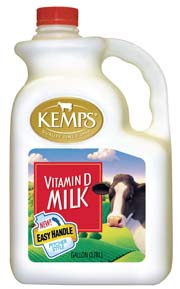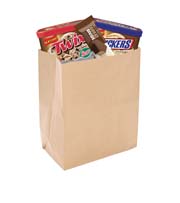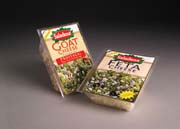It wasn't that long ago that the only discussions about dairy packaging revolved around function and price-good seal, easy storage easier handling less expensive materials, and lower shipping costs. Certainly each of these issues is still crucial to any dairy operation. But milk processors and their cheese, yogurt and ice cream counterparts are also talking about bottle contours, ergonomics, and even environmental impact--issues that are as big a concern to the consumers as they are to those in the supply chain.
You've come along way Bessie, and things are just getting started!

The jug, the Chug and beyond
When you talk about dairy products, pound-for pound there's still no bigger segment than milk and other dairy beverages. And this is any arena where some of the most innovative and some of the most arcane packaging share shelf space.The basic, blow molded milk jug and cap falls into that area of utilitarian discussion. Screw caps or snap caps? With or without a foil or plastic seal? And maybe we should put a label on the front and second one on the back.
But there's always the exception. For many years, companies like Mayfield Dairy, Purity Dairies and HP Hood have offered jugs that protect milk from damage caused by ultraviolet light. A few years back, SouthWest dairies began putting 360 degree stretch sleeve labels on half-gallons and gallons in its Dairy Pride line of milk.
Other companies have introduced milk jugs with a shape that makes them easier to handle.
Late last year, Kemps, of Minneapolis, which is now part of HP Hood, rolled out what it calls The Kemps Easy Handle Bottle. The new gallon jug is made of high-density polyethylene (HDPE) with an integral handle that gives the appearance of pitcher. And it's not just appearance.
Kemps says the jug may be the first ever to have an off center spout, which makes it easier to pour.
The new container was launched in December with a special promotion, "Official Milk of Santa."
Kemps blow-molds the jugs in-house, and worked with suppliers to design the mold and to adapt the filling equipment.
Down the river from Kemps, in La Crosse, Wis., convenience store chain Kwik Trip Inc. recently found a new cap and seal solution for its Nature's Touch-brand milks. It's a solution to one of those function issues, but it also provided convenience and peace of mind for consumers.
The company's standard snap/screw caps were difficult to apply at the plant, and the seals didn't always hold. Simplifying operations and minimizing leakers were the initial motivators that had Kwik Trip looking for a foil seal cap option at Pack Expo, says Richard Carr, dir. of dairy operations.
Kwik Trip came across a new product offered by Portola Packaging, Batavia, Ill. The two piece molded cap features a pull-ring seal, similar to those used in high-end gabletop spout fitments.
The result is a seal that performs well, costs about the same as a foil seal, and does not require sealing equipment.
"I'm a typical small plant person in that I have a limited amount of floor space, so I kept thinking how was I was going to get a heat sealer in there if we were going to foil," Carr says.
That's great for Kwik Trip, but how would the customer like it? To its credit, the company ran a trial with survey cards asking customers what they thought of the new cap.
"Seventy-six percent sent this back indicating that the milk was fresher," Carr said. "It as kind of amazing, and we hadn't really thought of that. We were just concerned about whether or not it would be easy to open."
Kwik Trip has converted all half-gallon and gallon jugs to the cap, including juice drinks and water.
The cap is a two piece mold with the ring and fitment welded and a screw on cap already applied. Kwik Trip simply snaps it on after filling.
It's been more than 10 years since Dean Foods introduced the Chug, and it's still paying dividends by forging a new path to significantly higher sales in the foodservice channel.
The full covered shrink sleeved resealable bottle has become the standard package for single-serve milk.
Some related package innovation has cropped up recently in the competitive arena of non-dairy creamers. The race for market share generated a unique package that was recognized last year with DuPont Company's prestigious Diamond Award for outstanding packaging.
International Delight and Coffee Mate are the leading national brands in the value- added non-dairy creamer category. Over the years both have introduced flavors and improved packaging. But when Coffee Mate came up with an easier to open top on its pint bottles the Morningstar Division of Dean Foods knew it had to score big with its next package upgrade.
The result is a bottle that can be opened, poured and resealed with one hand. How's that for convenience!
The Diamond Award is part of the DuPont Awards for Innovation in Packaging. Entries are in for the 2005 awards program and awards will be announced Aug. 5 at the Kimmel Center for the Performing Arts, Philadelphia. This is the 18th year that DuPont has given the awards to recognize outstanding packaging products made from plastics.

Easy on the earth
Convenience is not the only added value consumers are willing to pay for. Those who purchase organic and natural food products want packaging that's easy to use, but also easy on the earth.So it's no surprise that the first dairy application for NatureWorks® PLA plastics is an organic milk bottled in Iowa.
NatureWorks, devolved by Cargill Dow, LLC, Minnetonka, Minn., is a unique, renewable material that can be blow molded just like HPDE. NatureWorks is made from corn and it's biodegradable.
Naturally Iowa, LLC, Clarinda, Iowa, is a consortium of Midwest dairy farms that adhere to the guidelines for "natural" food products, or "organic" certification by an authorized organic certification agency.
Naturally Iowa, and a Colorado water bottler are among the first beverage companies to bottle products in corn-based NatureWorks PLA, and they are relying on the natural packaging to help them vie for shopper attention and shelf space.
"With an explosion of waters, juices, teas and other drinks crowding the beverage case, it's easy for new products to get lost in the clutter," said Brian Glasbrenner, business development manager with Cargill Dow. "That's why these beverage companies sought a new path to innovation - a one-of-a-kind bottle."
Naturally Iowa's dairy products and NatureWorks PLA both get their start on the farms of southwestern Iowa, hence the co-op dairy's slogan: "We milk the cows and grow the bottles."
What began as an endeavor by several dairy farmers to add value to their commodity by selling direct to consumers has blossomed into a growing line of organic and natural dairy products, including fluid milk in an assortment of serving sizes and several flavors of "spoonless" yogurt. Right now, Naturally Iowa packages its natural and organic milk in a half-gallon "grip" bottle of NatureWorks PLA, and is working with Cargill Dow to develop bottles for its single-serve beverages.
Naturally Iowa President Bill Horner credits NatureWorks PLA for helping its brand differentiate through packaging. "The natural bottle is our hook-without it, we would only have half the story," he said.

We all scream for novelties
The frozen novelty market continues to grow, primarily due to the strength of sales at convenience stores, kiosks, vending machines, stadiums and amusement parks-the impulse markets-where frozen novelties feed a consumer's desire for an on-the-go treat. Here in these outlets, both stick and non-stick frozen novelties must compete with snack foods and confectionery items that have long been packaged in films with snappy graphics."Appearance is a key differentiating factor in these competitive point-of-purchase markets," says Gregg Ockun, project manager, ExxonMobil Chemical. "Ice cream novelties packaged in film have a much better chance of attracting the consumer's attention and increasing sales. The winners in this market are products packaged in glossy, bright, eye-catching graphics, and a quality look."
ExxonMobil Chemical currently offers five oriented polypropylene (OPP) films designed specifically for frozen novelty packaging applications. As a replacement for paper, ExxonMobil's OPPalyte® line of films provides products with increased shelf appeal, added protection from moisture, and a platform for improved graphics. In addition, OPP film rolls weigh considerably less than paper rolls, enhancing convenience and safety.
"For several years now, the major marketers such as Häagen-Dazs, Good Humor and Nestlé have used OPP film to improve shelf appeal and freezer endurance of their products," adds Ockun. "Now we're seeing a significant number of mid-to small-sized regional dairies change their packaging to film with great results. They're competing with the industry's main players and doing very well."
A good example is Ellsworth Ice Cream, Saratoga Springs, N.Y. Established in 1933, Ellsworth is primarily a manufacturer of private label ice cream and novelties.
The company found it needed to upgrade to film wrappers not only to break into the single-serve market, but to satisfy private-label customers of its ice cream multipacks. So recently the company made the switch with the help of ExxonMobil Chemical.

Smoothie looking
Last spring, Old Home Foods, St. Paul, Minn., introduced a line of light yogurt smoothies. This was a fat-free, lower-calorie and lower carbohydrate line extension of its Original Old Home Yogurt Smoothies that were launched a year earlier. The light products include five fruity flavors in an 8-oz HDPE bottle-the Orignal is offered in 10-oz bottles. After searching for a bottle with the right shelf appealing, Old Home came up with a curvy 8-oz bottle by going to a custom design and blow-mold company, Sonoco, Hartsville, S.C.Old Home, which does a good deal of contract manufacturing on its dedicated drinkable yogurt filler line, says it put considerable thought into the shape of the bottle. It wanted a sexy shape and an ergonomic feel particularly to woman's hand.
Bottles are blow molded by Sonoco, and labels are applied before they are shipped to Old Home.

Sidebar: Cheese Maker Finds Film Solution for Crumpled Salad Cheeses
Fleur de Laits, New Holland, Pa., markets the Saladena® brand of salad cheeses in a two-piece package featuring a patented EZ Peel® / Reseal opening feature from Curwood Inc., Oshkosh, Wis.The Saladena line includes three varieties: feta, goat and blue cheese. Each comes in a four-ounce clear thermoformed tray sealed with a flexible film lid. Fleur de Lait adds a printed label with branding graphics on top, and a printed nutrition label on the bottom of the tray.
The EZ Peel / Reseal feature is actually built into the tray film-not the lidding stock. Curwood buries the peel/reseal layer into the core of the multi-layer, coextruded film. The design allows for a controlled delamination to occur when the lid is peeled back, and it enables the sealing operation to occur independent of dwell time.
"That gives us a fairly wide sealing window, both in terms of temperature and time," says Bobbie Sue George, purchasing manager for Fleur de Lait.
The semi-rigid tray film consists of polyethylene (PET), the peel / reseal layer and a sealant layer; the lidding film is an oriented polyethylene (OPET) with a double layer of Surlyn. Both films have excellent oxygen barrier characteristics.
The Saladena line is packaged in horizontal form/fill/seal equipment at Fleur de Lait's New Holland plant (blue cheese variety) and its Lena, Ill. plant (feta and goat varieties). Everything - including thermoforming the trays - is done inline. "We started using the Curwood films about four years ago," says George. "It replaced another tray-and-lid system, but one without the reseal feature. In addition to the obvious convenience aspect, we liked the fact that we could use these films on existing equipment."
Sidebar: New York Cheese Operation Cuts Costs with Rollstock
New York-based Ahava Food Corp. Ahava recently upgraded the packaging for its sliced and shredded hard cheeses to rollstock, immediately boosting production by over 100%, cutting costs by 30%, and dramatically improving the appearance of its products on the retail shelf."To understand the difference a package can make, you really have to see it for yourself," says Yehuda Banayan, who is in charge of purchasing for Ahava, which makes specialty kosher products. "We have completely overhauled the look and image of our hard cheeses through this new packaging, and our distributors, retailers and consumers see the improvement."
Ahava switched from manual vacuum packaging to a fully automated compact rollstock system from Multivac, Kansas City, Mo. Now, rather than stuffing pre-formed bags with sliced or shredded cheese, Ahava packages the products in-line. Roll-fed flexible film is heated and stamped to form a tray into which the product is loaded. Meanwhile, a space-saving Multivac 615 cross-web top labeler affixes custom-designed labels onto a top web of film with accuracy of +/- .5mm. As the loaded trays move through the system, the now-labeled top web of film is applied and heat-sealed to form the vacuum packages, which are then automatically cut to exact specifications for the retail shelf. With the success of the transition to rollstock, the company purchased a second Multivac rollstock machine, the new compact R140, to further expand and speed production.